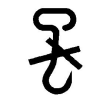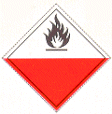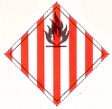| Palm fiber | [German version] |
Table of contents |
|
| General: | ||
| Product information | ||
| Packaging | ||
| Transport | ||
| Container transport | ||
| Cargo securing | ||
Product information
Product name
| German | Palmfasern, Palmfiber |
| English | Palm fiber |
| French | Crin végétal |
| Spanish | Fibra de palma |
| Scientific | Chamaerops humilis |
| CN/HS number * | 5305 9 ff. |
(* EU Combined Nomenclature/Harmonized System)
Product description
Palm fiber belongs to the category fibers/fibrous materials, which are classified as follows [24]:
Plant hairs:
| Cotton seed-hairs | |
| Kapok tree fruit hairs |
Stalk fibers from dicotyledonous plants (soft fibers):
| Flax, ramie (fine spinnable fibers) | |
| Hemp, jute, kenaf (coarse spinnable fibers) |
Leaf fibers (hard fibers):
| Sisal, Manila hemp, palm fibers (poor spinning characteristics) |
Bast:
| Linden, raffia palm, willow |
Basketwork material:
| Coconut fiber, rattan cane, halfa, piassava, esparto |
Palm fiber is a leaf fiber (hard fiber) obtained from the leaves of the dwarf palm (Chamaerops humilis), a member of the palm family (Palmae). It is also known as vegetable horsehair.
The dwarf palm, Europe’s only wild palm, is a fan palm which grows in the western Mediterranean area forming knee-high undergrowth in North Africa and Southern Spain.
During the dry season, the fibers are obtained from the leaves by mowing, hackling, combing and spinning. The greenish fibers are traded as twisted hanks.
Quality / Duration of storage
Palm fiber has poor spinning characteristics.
If bales are moist on the outside or inside, there is a risk of discoloration (from green to black), mustiness and mold growth. A moisture measurement must therefore be carried out before accepting the consignment and moisture-damaged bales must be rejected.
Subject to compliance with the appropriate temperature and humidity/moisture conditions, duration of storage is not a limiting factor as regards transport and storage life.
Intended use
Vegetable horsehair is characterized by good elasticity and is thus suitable as stuffing for furniture and mattresses and for use in ropemaking and basket weaving.
Figure
(Click on the individual Figures to enlarge them.)
 Figure 1 |
Countries of origin
This Table shows only a selection of the most important countries of origin and should not be thought of as exhaustive.
| Europe | Southern Spain, Southern Italy |
| Africa | Morocco, Egypt |
| Asia | |
| America | |
| Australia |
Back to beginning
Packaging
Palm fibers are twisted and consolidated into 65 – 85 kg bales and strapped with nonmetallic ties.
| Marking of packages | ||
 Keep dry |
 Use no hooks |
 Keep away from heat (solar radiation) |
Back to beginning
Transport
Symbols
 Spontaneously combustible, Class 4.2 IMDG Code |
 Fire hazard (Flammable solids), Class 4.1 IMDG Code |
 General cargo |
Means of transport
Ship, truck, railroad
Container transport
Standard containers , subject to compliance with water content of goods, packaging and flooring.
Cargo handling
In damp weather (rain, snow), the cargo must be protected from moisture, since palm fiber is strongly hygroscopic and readily absorbs moisture. This may lead to discoloration and fungal attack.
Do not use hooks for cargo handling, since they may lead to sparking when they come into contact with metal objects.
In addition, smoking is absolutely prohibited during cargo handling.
Stowage factor
| 3.50 m3/t (bales, unpackaged) [1] | |
| 5.66 m3/t (bales)[1] | |
| 4.53 m3/t (bales, hand compressed) [1] | |
| 2.43 m3/t (bales) [14] |
Stowage space requirements
Cool, dry
Segregation
Fiber rope, thin fiber nets
Cargo securing
The cargo is to be secured in such a way that the bales or strapping are not damaged. Undamaged strapping is essential to maintain compression of the bales during transport. If the strapping is broken, compression is diminished, which at the same time results in an increased supply of oxygen to the inside of the bales. This in turn increases the risk of combustion or feeds a fire which has already started.
Back to beginning
Risk factors and loss prevention
RF Temperature
Palm fiber requires particular temperature, humidity/moisture and possibly ventilation conditions (SC VI) (storage climate conditions).
Favorable travel temperature range: no lower limit – 25°C
Palm fiber must be stowed away from heat sources.
Every hold should be equipped with means for measuring temperature. Measurements must be performed and recorded daily.
Back to beginning
RF Humidity/Moisture
Palm fiber requires particular temperature, humidity/moisture and possibly ventilation conditions (SC VI) (storage climate conditions).
| Designation | Humidity/water content | Source |
| Relative humidity | 65% | [1] |
| Water content | 12% | [14] |
| Maximum equilibrium moisture content | 65% | [1] |
Palm fiber is strongly hygroscopic (hygroscopicity). It must be protected from sea, rain and condensation water and also from high levels of relative humidity.
Severe exposure to moisture may cause the fibers to discolor, perhaps even to blacken. This reduces the value of the product, possibly to zero.
Moreover, after a time even slight moisture may impart a musty odor to the palm fiber. As a result, it is no longer usable for its principal application, upholstery stuffing.
Rain may have fallen on the product during storage before shipment in sheds without walls or during loading, while an excessive intrinsic moisture content combined with inadequate ventilation may result in mold growth and heating.
It is advisable to carry out moisture measurements before accepting a consignment. Moisture-damaged bales and hanks must not be accepted.
Back to beginning
RF Ventilation
Palm fiber requires particular temperature, humidity/moisture and possibly ventilation conditions (SC VI) (storage climate conditions).
If the product is loaded for shipment in a dry state, it does not have any particular ventilation requirements.
Problems arise if the product, packaging and/or ceiling/flooring are too damp. In this case, the following ventilation measures should be implemented:
Air exchange rate: 10 – 20 changes/hour (airing)
Since palm fiber very readily absorbs oxygen, before anybody enters the hold, it must be ventilated and a gas measurement carried out, since a shortage of oxygen may endanger life.
Back to beginning
RF Biotic activity
Palm fiber displays 3rd order biotic activity.
They belong to the class of goods in which respiration processes are suspended, but in which biochemical, microbial and other decomposition processes still proceed.
Back to beginning
RF Gases
Palm fiber very readily absorbs oxygen. An oxygen shortage may therefore arise in closed holds and containers. Before anybody enters such holds, the holds must be ventilated and, if necessary, a gas measurement carried out.
An increase in CO2 and CO content indicates a cargo fire. The TLV of the hold air is 0.49 vol.%.
Back to beginning
RF Self-heating / Spontaneous combustion
Palm fiber is assigned to Class 4.1 of the IMDG Code (Flammable solids). However, its specific characteristics and negative external influences (see below) may cause them to behave like a substance from Class 4.2 (Substances liable to spontaneous combustion) of the IMDG Code or ADR.
Its high cellulose content makes palm fiber liable to catch fire through external ignition. Therefore, protection from sparks, fire, naked lights and lit cigarettes must always be provided. Smoking is absolutely prohibited. In accordance with the IMDG Code, ventilation openings leading into the hold should be provided with spark-proof wire cloth.
Spontaneous combustion may occur as a result of exposure to moisture, animal and vegetable fats/oils, oil-bearing seeds/fruits, copra and raw wool.
Fire-fighting is best performed using CO2 or foam. When fighting a fire, do not break the strapping or open the bales, since relieving the compression increases the oxygen supply and makes it impossible to fight the fire effectively.
Water must not be used for fire-fighting, as this results in damage to the product.
Back to beginning
RF Odor
| Active behavior | Palm fiber has a slight, pleasant, straw-like odor. Even slight moisture may impart a musty odor to palm fiber after a time. As a result, it is no longer usable for its principal application, upholstery stuffing. |
| Passive behavior | Palm fiber is sensitive to unpleasant or pungent odors. For example, fish meal stowed nearby may result in considerable depreciation of the palm fiber. |
Back to beginning
RF Contamination
| Active behavior | Palm fiber causes contamination by forming dust. |
| Passive behavior | Palm fiber is sensitive to contamination by dust, dirt, fats/oils and rust as well as oil-containing goods, such as oil-bearing seeds/fruits, copra, raw wool etc., since oil-impregnated fibers promote self-heating/cargo fire. Holds or containers must accordingly be clean and in a thoroughly hygienic condition. |
Back to beginning
RF Mechanical influences
Care must be taken to ensure that mechanical influences do not cause damage to strapping, which increases the risk of fire by relieving the compression of the bale and allowing a greater supply of oxygen. Use no hooks.
Back to beginning
RF Toxicity / Hazards to health
Since palm fiber is highly oxygen-absorbent, a life-threatening shortage of oxygen may arise in the hold or container. Thus, before anybody enters the hold, it must be ventilated and, if necessary, a gas measurement carried out. The TLV for CO2 concentration is 0.49 vol.%.
Back to beginning
RF Shrinkage/Shortage
Weight losses may amount to approx. 2% due to drying of the seasonally determined water content.
Unclearly marked bales may result in losses of volume due to incorrect delivery.
Back to beginning
RF Insect infestation / Diseases
No risk.
Back to beginning
